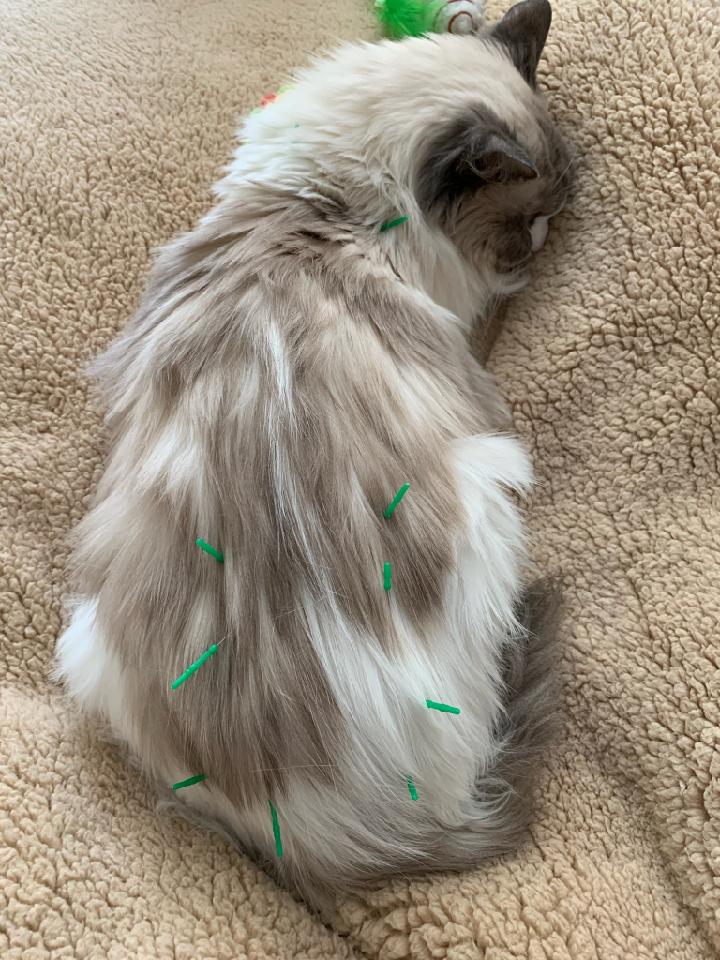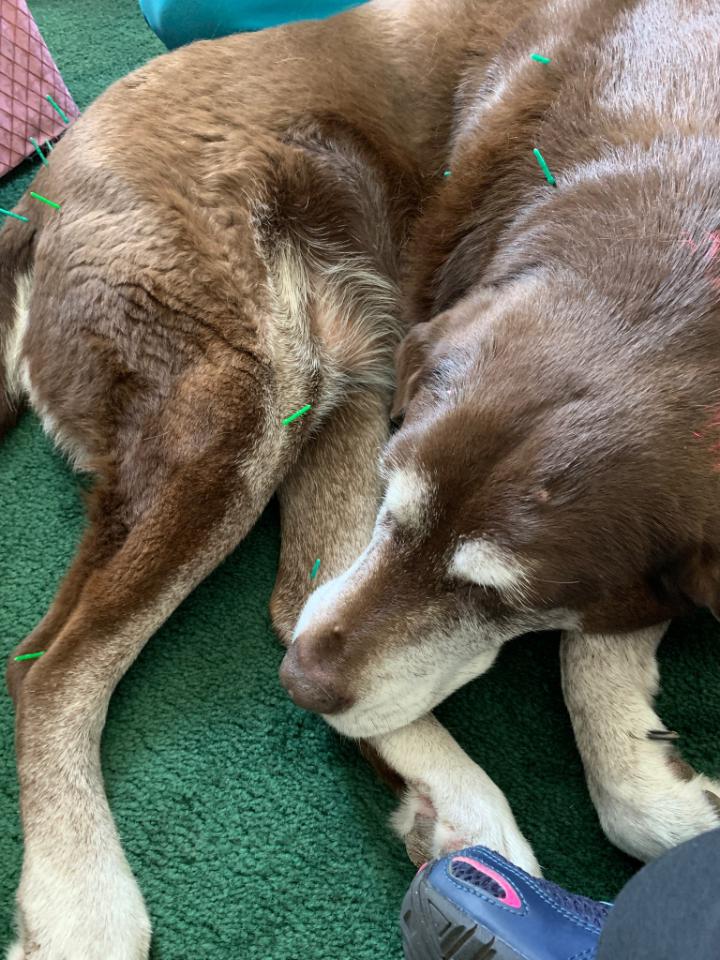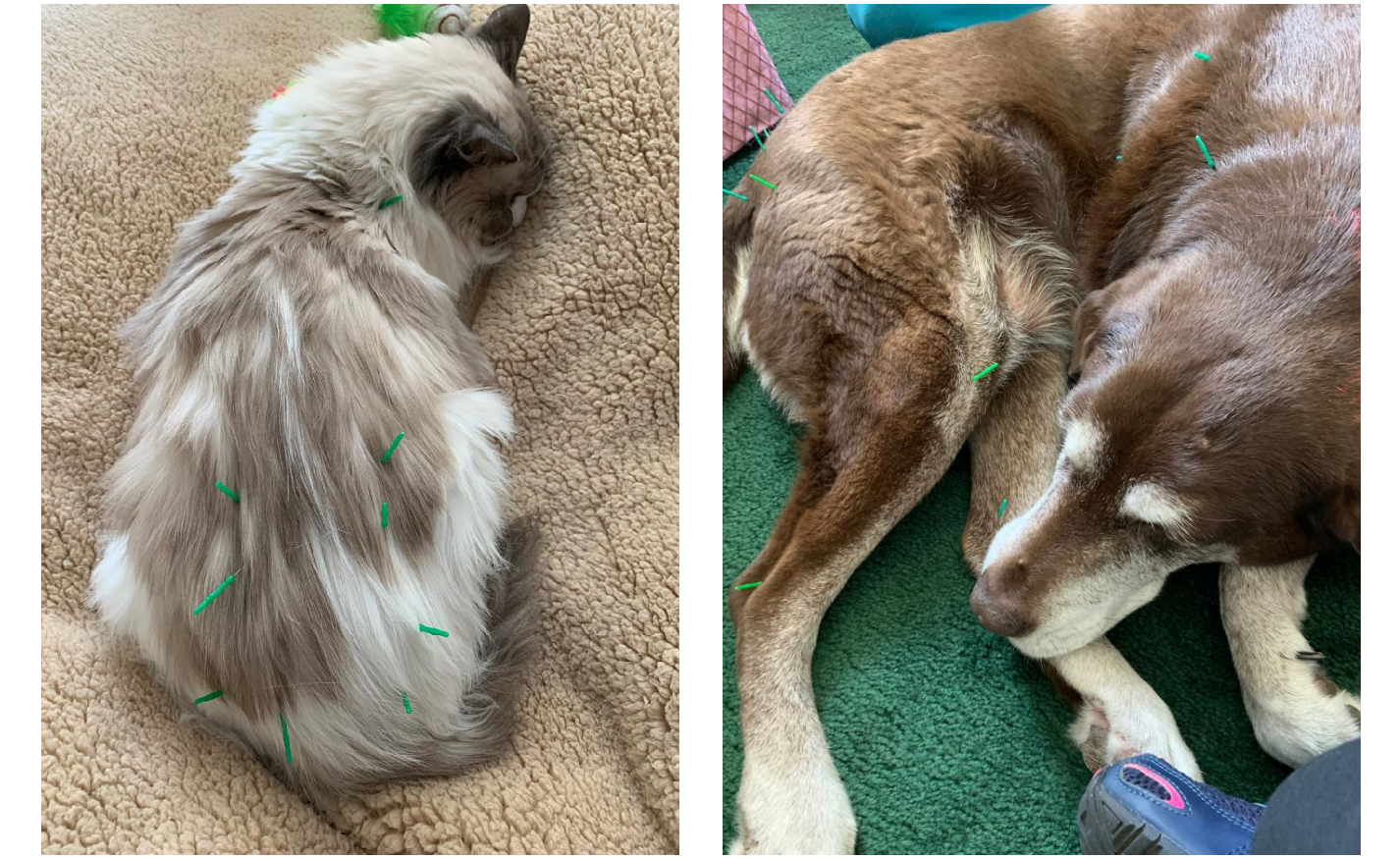Tabitha, an 18-year-old sweet-natured cat, had trouble moving comfortably around the house, and her owners had exhausted the many methods offered to relieve the pain caused by her arthritis. Acupuncture was suggested to Tabitha’s owners, and despite being a bit skeptical of the true effectiveness of this treatment, they scheduled Tabitha’s first acupuncture appointment.
Acupuncture treatment is administered to a feline patient. (Photo by Dana Koch, VMD, CVA, MLAS)

Tabitha was a very cooperative patient and seemed to enjoy her acupuncture treatments. After approximately six treatments, Tabitha’s owners noticed that Tabitha walked with a bit more energy, had improved movement and was less stiff. Treatments continued over a year, and the owners noticed improvements in Tabitha’s daily life, including better grooming, sleeping more comfortably, toileting with ease and an increased appetite. Amazingly, Tabitha did not require any pain medication during her acupuncture treatments and was able to celebrate her 22nd birthday. Tabitha was an exemplary embodiment of the true benefits acupuncture can bring to our furry companions.
What is Acupuncture?
Acupuncture has been around for thousands of years. The therapy originated in China, where traditional Chinese veterinary medicine includes not only acupuncture but also herbal medicines, dietary therapy, and tuina (medical procedures). Animals have around 173 acupuncture points, while humans have around 361. Acupuncture typically involves inserting thin, sterile needles into specific points on the body to achieve therapeutic benefits. Other methods, such as electrical stimulation and moxibustion, are also utilized to enhance the effectiveness of acupuncture. Moxibustion uses a dried plant material called moxa, which is burned close to the surface of the skin to help treat certain conditions. Electroacupuncture uses a gentle, mild electrical current between the inserted needles to stimulate and enhance the effectiveness of acupuncture for certain conditions.
Acupuncture helps patients
Regarding the effectiveness of acupuncture, several studies have demonstrated that stimulating acupuncture points releases beta-endorphins, serotonin, and other neurotransmitters. Additionally, studies have shown that acupuncture can help relieve pain, promote tissue healing processes, regulate gastrointestinal motility, provide immune regulation, have anti-inflammatory effects, and regulate hormones.
The best thing about acupuncture is that it is extremely safe with very few side effects. In some cases, results are immediate, while in other cases multiple treatments may be necessary. Most animals tolerate acupuncture needles very well and often even find a relaxing effect from a few acupressure points being applied. There are many interconnected pathways in the body that can be stimulated with acupuncture. Many veterinarians who practice acupuncture are able to use these pathways to treat multiple areas of the body with just a few acupressure points.
Veterinary acupuncture practice
To become a certified veterinary acupuncturist, a practicing veterinarian must undergo extensive training in understanding the history of acupuncture, properly diagnosing patients, and understanding the pathways and meridians used in acupuncture therapy. These trained professionals must pass several tests to become proficient and certified.
A canine patient receives acupuncture treatment. (Photo by Dana Koch, VMD, CVA, MLAS)

In fact, owners often have their animals eat their favorite treats or food during the acupuncture treatment to ensure the animal has a positive experience. Most treatments last between 15 and 30 minutes. The most common conditions for which acupuncture is used in animals include musculoskeletal and neurological injuries, gastrointestinal disorders, allergic dermatitis, lick granulomas, epilepsy, and chronic pain.
Conclusion
If you are considering this treatment for your pet, we encourage you to find a certified veterinary acupuncturist near you. The acupuncturist will review your pet’s full medical history and perform a thorough exam prior to acupuncture treatment. The acupuncturist may also recommend dietary changes and/or herbal medicines to treat the underlying issue.
I have found that an integrative approach using elements of both traditional Western medicine (e.g. x-rays, ultrasound, antibiotics) and Eastern medicine (e.g. acupuncture, herbs) to treat patients is most effective. Today, we are fortunate to have many options to help animals live longer, more comfortable lives.
Dana Koch, VMD, CVA, MLAS He is the medical director of House Paws Hospital, an acupuncture hospital in Morrisville, Pa. He earned his veterinary medicine degree from the University of Pennsylvania and his master’s degree in laboratory animal medicine from Drexel University in Philadelphia.

